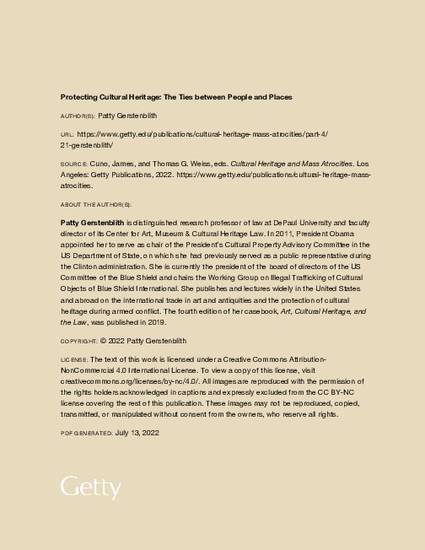
Contribution to Book
Protecting Cultural Heritage: The Ties between People and Places
Cultural Heritage and Mass Atrocities: Legal, Political, and Humanitarian Perspectives
(2022)
Abstract
The chapter examines the destruction of immovable cultural heritage through the lens of human rights and argues that the meaning of cultural heritage must be evaluated from the perspectives of the international, regional, national, and local communities. It briefly summarizes applicable international legal instruments and the categorization of cultural heritage destruction within the rubric of mass atrocity crimes: genocide, crimes against humanity, and war crimes. The discussion then turns to the emerging norm of the responsibility to protect (R2P), analyzing in particular the potential applicability of R2P’s third pillar to the preservation of immovable heritage. Four elements are evaluated from the perspective of legitimacy and feasibility: military intervention, criminal responsibility, involvement of nonstate actors, and the safeguarding of cultural heritage. The chapter concludes that involving local communities and nonstate actors in preservation and protection efforts is likely to be more successful than a top-down approach that focuses primarily on the interests of states and intergovernmental organizations.
Disciplines
Publication Date
2022
Editor
James Cuno and Thomas G. Weiss
Publisher
Getty Publications - available online at www.getty.edu/publications/cultural-heritage-mass-atrocities
ISBN
978-1-60606-807-6
Publisher Statement
Intentional destruction of cultural heritage has a long history. Contemporary examples include the Bamiyan Buddhas in Afghanistan, mosques in Xinjiang, China, mausoleums in Timbuktu, Mali, and Greco-Roman remains in Syria. Cultural heritage destruction invariably accompanies assaults on civilians, making heritage attacks impossible to disentangle from the mass atrocities of genocide, war crimes, crimes against humanity, and ethnic cleansing. Both seek to eliminate people and the heritage with which they identify.
Cultural Heritage and Mass Atrocities assembles thirty-eight experts from the heritage, social science, humanitarian, legal, and military communities. Focusing on immovable cultural heritage vulnerable to attack, the volume’s guiding framework is the Responsibility to Protect (R2P), a United Nations resolution adopted unanimously in 2005 to permit international intervention against crimes of war or genocide. Based on the three pillars of prevent, react, and rebuild, R2P offers today’s policymakers a set of existing laws and international norms that can and—as this book argues—must be extended to the protection of cultural heritage. Essays consider the global value of cultural heritage and document recent attacks on people and sites in China, Guatemala, Iraq, Mali, Sri Lanka and Afghanistan, Syria, and Yemen. Comprehensive sections on vulnerable populations as well as the role of international law and the military offer readers critical insights and point toward research, policy, and action agendas to protect both people and cultural heritage. The table of contents along with a concise abstract of each chapter is offered online in Arabic, Chinese, French, Russian, and Spanish to facilitate robust, global dissemination of the strategies and tactics offered in this pathbreaking call to action.
Citation Information
https://www.getty.edu/publications/cultural-heritage-mass-atrocities/
